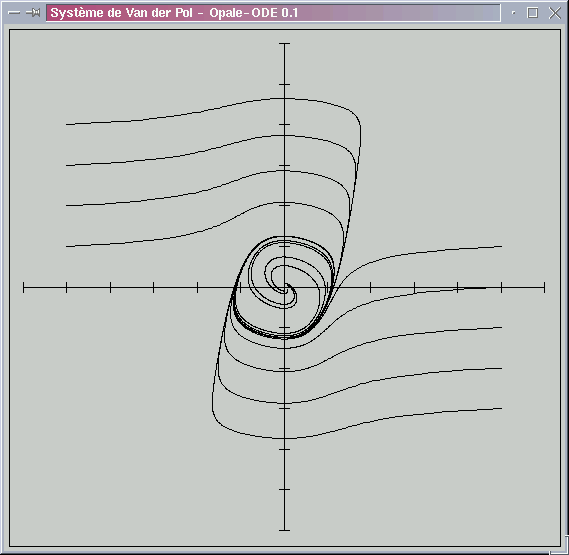|
Module examplesYou can use this module in two ways. Direct use of module classesYou can directly use module classes in a Java program. Let's suppose we wish to solve the following problem:
First of all, let's create a problem, then an Euler scheme (explicit in our case) by precising number of time steps and linking to the problem the scheme, the initial condition and the equation (to have a lighter and more readable program, we are using internal class mecanism). Then, you can solve the problem by calling solve(). Here is a way to do it in the next program :
import opale.tools.*;
import opale.mathtools.*;
import opale.ode.*;
import opale.ode.scheme.*;
public class exemple
{
public static void main(String[] arg)
{
Problem pb = new Problem();
ExplicitEuler ts = new ExplicitEuler();
ts.setNstep(100);
DVect cd = new DVect(1);
cd.set(0,1);
pb.setInit(cd);
pb.setEqn(new Equation() {
public int dim() { return 1 ; }
public DVect derivs(double t, DVect x) {return x;}
}
);
pb.setTS(ts);
pb.solve();
System.out.println(pb.printSol());
}
}
You can use ODE in another way : ODE data files which allow to read/write problems in a fixed format. Data filesWith data files you can save/read a problem in/from a text file and then solve problems. Keep in mind that data sets have only a meaning when the problem dimension is included from 1 to 3. The reason is simple : the equation interpreter used in Opale can read only variables t, x, y, z in a text format file. A data set is a text file containing equation descriptions, time schemes and problems to solve. Its structure is simple, look at by yourself : Equation eq
{
f1(t,x,y,z)= '3*t'
f2(t,x,y,z)= '3'
f3(t,x,y,z)= '1'
}
ExplicitEuler sc
{
tmin 0
tmax 1
N 100
}
Problem pb
{
dim 3
sch sc
eqn eq
y0 1 1 2
}
We have 3 blocks describing first the equation, then the time scheme and at last the problem to solve. Each block contains at the beginning the object type name which will be described below (Equation, ExplicitScheme or Problem), followed by an id chosen by the user (eq, sc, pb). Let's see how to use them in a Java program. We have already written the previous data file in file1.ode and we want to write a program able to read this file to solve it. It should be like that :
import opale.ode.*;
import opale.ode.scheme.*;
import opale.tools.*;
public class file
{
public static void main(String[] arg)
{
try
{
ODE ode = new ODE();
StreamReader rf = new StreamReader("file1.ode");
ode.read(rf);
ode.solve();
System.err.println(((Problem) ode.getObject("pb")).printSol());
rf = new StreamReader("file2.ode");
ode.clear();
ode.read(rf);
ode.solve();
System.err.println(((Problem) ode.getObject("pb_ee")).printSol());
}
catch(java.io.IOException e)
{}
catch(InvalidFormatException e)
{System.err.println(e);}
}
}
Let's focus on a new class : ODE which encaps an ODE module object set. To read a data file, you must create a ODE type object and call its method read(StreamReader). ODE object will then create objects of type Equation, TimeScheme and Problem. You can after access to them thru ODE method ObjectODE getObject(String id) where id is the object identifier (name given in the data file). To solve the problem, you just need to call solve() which will solve each problem (in our case only one). GUIIt's now possible to use a program build directly on ODE module. For example, the applet AODE, or the software GEOODE.
Module evolutionODE module is by design easy to modify. Future scheduled developments are :
A last exampleTo finish, let's see the display of a problem whole processed by Opale tools : it's Van der Pol problem solved by ODE module and displayed by 2D module. Look at the source file. 
Opale Team : January 31 2004 23:14:10. |

|

|

|

|

|
